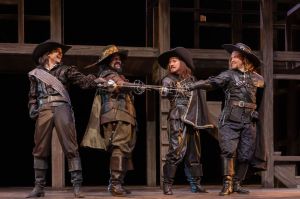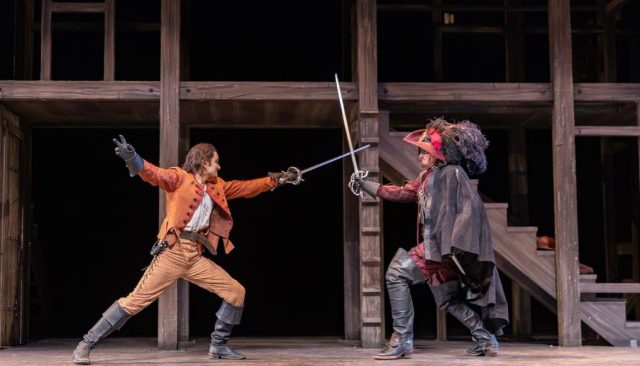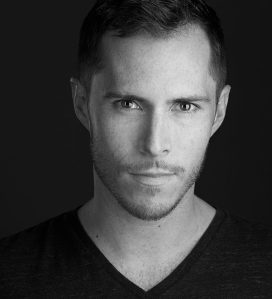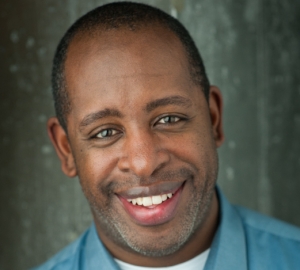
Steve Jodoin, Mélissa Merlo, Stéfanelle Auger in Trout Stanley, L’UniThéâtre/ Théâtre Niveau Parking. Photo by Emilie Dumais
By Liz Nicholls, 12thnight.ca
There is a kind of kooky mania — or is it frazzled euphoria? — about the captivatingly weird play that’s currently running, for the first time ever in French, at L’UniThéâtre.
You couldn’t go wrong calling Trout Stanley, by the poet/ novelist/ playwright Claudia Dey, Canadian Gothic. It plants that flag on a garbage dump in the B.C. hinterland, and ups the ante in a macabre but shimmery world with “a death spell.” But it’s sort of a thriller (there’s a murder mystery and a mysterious outsider), too. And sort of a romantic comedy (there’s love at first sight). But more of a black comedy with a wacky realism/surrealism mix, captured perfectly in Vano Hotton’s design (lighting by Denis Guérette), which surrounds the raised platform of the stage with garbage bags and shiny magical draperies. And it’s all ignited by startling, extravagant verbal fireworks.
To help support 12thnight.ca YEG theatre coverage, click here.
In a remote town somewhere between Misery Junction and Grizzly Alley, we meet the orphaned Ducharne twins, Grace and Sugar, who were once triplets, on their 30th birthday. Grace (Stéfanelle Auger) runs the town garbage dump, and poses (as she demonstrates) for hunting season catalogues and billboards. Her birthday present to her sister Sugar (Mélissa Merlo) is a rifle. The latter, a woebegone recluse who’s worn their dead mother’s tracksuit for 10 years (and hasn’t left the house in that decade), makes “tragic figurines.”
Every year on their birthday something terrible happens, and on the eve of their big 3-oh, it’s happening again: a murdered stripper who’s the town Scrabble champion.
And there’s this possibly sinister development: into the odd sibling equilibrium of Grace and Sugar crashes a rumpled drifter looking more than a little worse for wear in a borrowed (stolen?) cop’s uniform. He is, he says, “looking for something I lost.” As Steve Jodoin conveys he’s a peculiar combination of menacing and addled. And his name is Trout Stanley. What kind of name is that? he’s asked. “A fish name.” His parents drowned before he could ask them why. And he’s looking for the offending lake.
Trout, who’s taken a vow of silence discovers Sugar in the process of hanging herself from a light fixture, and falls in love with her at first sight. An oddball courtship follows, marked by a veritable explosion of language in original combinations, and unusual confessions (as well as Jason Kodie’s apt soundscore, which veers wildly between romantic lute motifs and driving rock). “I’m a fainter,” she tells her suitor; she’s not toppled by the bizarre or the gruesome, but by “regular everyday things.”

Stéfanelle Auger and Mélissa Merlo in Trout Stanley, L’UniThéâtre/ Théâtre Niveau Parking. Photo by Emilie Dumais
The word count, which happens in short outbursts and long, escalating, image-filled monologues, is astronomical. Trout, a sort of wandering philosopher and part-time foot fetishist who’s taken a vow of silence that’s been unbroken in 10 years, till now, seems to have just re-discovered human speech. An he’s making up for lost time.
This eccentric trio is vividly, not to say hyperbolically, set forth by the cast of this L’UniThéätre co-production with Quebec City’s Théâtre Niveau Parking, directed by Hugues Frenette. The chosen acting style is heightened to say the least, and the deliberate quirkiness does grate a bit, until you get used to the world of the play.
Grace, the self-styled “Lion Queen” who has an earthy confidence about her in Auger’s performance, has the showbiz gene as she struts the stage posing in her copper cowboy boots, and declaring definitively on … anything. “Garbage tells me everything!” she says of her rapport with a job where you can learn a lot about humanity by looking at what humans throw away.
Sugar’s mopey-ness and low self-esteem are tuned to an amusingly phlegmatic matter-of-fact key, as captured by Merlo. It turns out she has a lot to say too, when she finally has someone to say it to. She compares her budding love affair with Trout thus: “Two snails. Meeting for the first time. On a beautiful day.”

Steve Jodoin and Mélissa Merlo in Trout Stanley. Photo by Emilie Dumais
Sugar is unlikely, incidentally, to receive much consolation from her sister. “If I was Sugar Ducharne I’d kill myself too,” declares Grace gracelessly. As Trout, Jodoin (the artistic director of L’UniThéâtre) captures a certain boy scout earnestness; he is, it turns out, an off-centre quester with the soul of a romantic. “No one should be alone.”
They’ve all lost something. And in their own idiosyncratic ways, they’re all waiting for something, too, desperate for love, and hoarding surprising caches of poetic language. It’s that need that makes you bear with them, and hope that their wacky fairy tale love triangle will have a happy ending.
REVIEW
Trout Stanley
Theatre: L’UniThéâtre and Théâtre Niveau Parking
Written by: Claudia Dey, translated by Manon St-Jules
Directed by: Hugues Frenette
Starring: Stéfanelle Auger, Steve Jodoin, Mélissa Merlo
Where: La Cité francophone, 8627 91 Street
Running: through Sunday
Tickets: lunitheatre.ca

 Shadow Theatre will launch its upcoming four-production 31st season with the world premiere of a new play by Edmonton’s Neil Grahn.
Shadow Theatre will launch its upcoming four-production 31st season with the world premiere of a new play by Edmonton’s Neil Grahn.



 •At Rapid Fire Theatre’s Exchange, through Saturday, enter the “realm of improvised nerdery” as billed. That would be the impossibly ingenious Improvised Dungeons & Dragons, led by the impossibly ingenious Dungeon Master Mark Meer, and fuelled by audience suggestions. Tickets:
•At Rapid Fire Theatre’s Exchange, through Saturday, enter the “realm of improvised nerdery” as billed. That would be the impossibly ingenious Improvised Dungeons & Dragons, led by the impossibly ingenious Dungeon Master Mark Meer, and fuelled by audience suggestions. Tickets: 


















